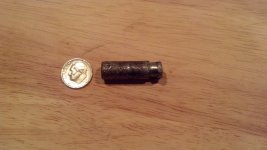So my TST system starts beeping. A quick check and one trailer tire is at 98 psi. Ok, change the tire. Turns out that I had a little something in the tire.
This is the third time that I have averted disaster. Had I not used a TPMS I would most certainly have had a blowout along with the customary damage.
The tire was determined to be marginal as the full time tire. It is now the spare.
If you don't use a TPMS you are running on borrowed time. IMO.
Attached is a pic of the little something that punctured my tire.
Peace
Dave
This is the third time that I have averted disaster. Had I not used a TPMS I would most certainly have had a blowout along with the customary damage.
The tire was determined to be marginal as the full time tire. It is now the spare.
If you don't use a TPMS you are running on borrowed time. IMO.
Attached is a pic of the little something that punctured my tire.
Peace
Dave

